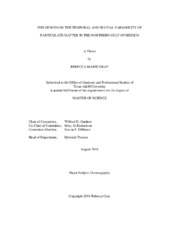| dc.description.abstract | The Mississippi River drains more than 3 million km2 of the North American continent and discharges 240 million metric tons of sediment and 1.35 million metric tons of nutrients annually into the Gulf of Mexico. This increase occurs primarily in the late winter and early spring, with nutrients fueling large algal blooms. The organic matter produced is grazed by zooplankton and decays as it sinks. The decaying organic matter utilizes oxygen, resulting in hypoxic conditions below the pycnocline when oxygen cannot be replenished by mixing. Measurements of oceanographic properties, including dissolved oxygen, temperature, salinity, and particle backscatter, were made with sensors on the CTD casts in June and August of 2010-2014 on the Texas-Louisiana shelf from Galveston Bay to the Mississippi River. These discharge conditions of these cruises are designed as flood, normal or drought based on the USGS Drought monitoring criteria. Discrete samples were collected from bottles on the CTD rosette, and continuous measurements were made with a towed undulating vehicle and a shipboard flow-through system.
Particulate matter (PM) concentrations in the surface waters increased with greater river discharge only during one flood period compared to a drought and normal period, showed no difference in concentration in months closer to peak discharge (June) compared with later (August) except in 2013, and showed increases in PM concentration for surface waters in areas closer to the freshwater sources (Mississippi, Atchafalaya, and Terrebonne Bay). Bottom PM concentrations increased with an increase in river discharge during a flood event when compared to a drought or normal event, indicated no difference in concentration in June (closer to peak discharge) compared with August, except again in 2013, and did not show a decrease with distance from the riverine source. Particulate organic carbon (POC) concentrations in the surface waters increase with increased river discharge during flood conditions, in months closer to peak discharge (June) compared with later (August), and in areas closer to river input. POC concentrations in the bottom waters do not show a difference with increase in river discharge or during months closer to peak discharge (June) compared with later (August) in any areas. | en |


